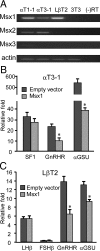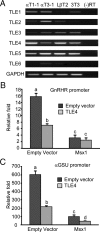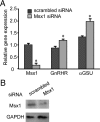Msx1 homeodomain protein represses the αGSU and GnRH receptor genes during gonadotrope development
- PMID: 23371388
- PMCID: PMC3589667
- DOI: 10.1210/me.2012-1289
Msx1 homeodomain protein represses the αGSU and GnRH receptor genes during gonadotrope development
Abstract
Multiple homeodomain transcription factors are crucial for pituitary organogenesis and cellular differentiation. A homeodomain repressor, Msx1, is expressed from the ventral aspect of the developing anterior pituitary and implicated in gonadotrope differentiation. Here, we find that Msx1 represses transcription of lineage-specific pituitary genes such as the common α-glycoprotein subunit (αGSU) and GnRH receptor (GnRHR) promoters in the mouse gonadotrope-derived cell lines, αT3-1 and LβT2. Repression of the mouse GnRHR promoter by Msx1 is mediated through a consensus-binding motif in the downstream activin regulatory element (DARE). Truncation and mutation analyses of the human αGSU promoter map Msx1 repression to a site at -114, located at the junctional regulatory element (JRE). Dlx activators are closely related to the Msx repressors, acting through the same elements, and Dlx3 and Dlx2 act as transcriptional activators for GnRHR and αGSU, respectively. Small interfering RNA knockdown of Msx1 in αT3-1 cells increases endogenous αGSU and GnRHR mRNA expression. Msx1 gene expression reaches its maximal expression at the rostral edge at e13.5. The subsequent decline in Msx1 expression specifically coincides with the onset of expression of both αGSU and GnRHR. The expression levels of both αGSU and GnRHR in Msx1-null mice at e18.5 are higher compared with wild type, further confirming a role for Msx1 in the repression of αGSU and GnRHR. In summary, Msx1 functions as a negative regulator early in pituitary development by repressing the gonadotrope-specific αGSU and GnRHR genes, but a temporal decline in Msx1 expression alleviates this repression allowing induction of GnRHR and αGSU, thus serving to time the onset of gonadotrope-specific gene program.
Figures








Similar articles
-
Glucocorticoids induce human glycoprotein hormone alpha-subunit gene expression in the gonadotrope.Endocrinology. 2008 Jul;149(7):3643-55. doi: 10.1210/en.2007-1100. Epub 2008 Apr 10. Endocrinology. 2008. PMID: 18403486 Free PMC article.
-
Msx1 homeodomain transcription factor and TATA-binding protein interact to repress the expression of the glycoprotein hormone α subunit gene.Biochem Biophys Res Commun. 2015 Dec 4-11;468(1-2):326-30. doi: 10.1016/j.bbrc.2015.10.102. Epub 2015 Oct 23. Biochem Biophys Res Commun. 2015. PMID: 26505791
-
GATA2-induced silencing and LIM-homeodomain protein-induced activation are mediated by a bi-functional response element in the rat GnRH receptor gene.Mol Endocrinol. 2013 Jan;27(1):74-91. doi: 10.1210/me.2012-1182. Epub 2012 Dec 4. Mol Endocrinol. 2013. PMID: 23211524 Free PMC article.
-
[An ambiguous role of steroidogenic factor 1 in the rat GnRH receptor gene expression. Lessons from transgenic mice].J Soc Biol. 2004;198(1):73-9. J Soc Biol. 2004. PMID: 15146959 Review. French.
-
Regulation of expression of mammalian gonadotrophin-releasing hormone receptor genes.J Neuroendocrinol. 2005 Oct;17(10):619-38. doi: 10.1111/j.1365-2826.2005.01353.x. J Neuroendocrinol. 2005. PMID: 16159375 Review.
Cited by
-
Expression stability of reference genes for quantitative RT-PCR of healthy and diseased pituitary tissue samples varies between humans, mice, and dogs.Mol Neurobiol. 2014 Apr;49(2):893-9. doi: 10.1007/s12035-013-8567-7. Epub 2013 Oct 18. Mol Neurobiol. 2014. PMID: 24135907
-
Intrahepatic homeobox protein MSX-1 is a novel host restriction factor of hepatitis B virus.J Virol. 2024 Feb 20;98(2):e0134523. doi: 10.1128/jvi.01345-23. Epub 2024 Jan 16. J Virol. 2024. PMID: 38226815 Free PMC article.
-
Characterization of murine pituitary-derived cell lines Tpit/F1, Tpit/E and TtT/GF.J Reprod Dev. 2014;60(4):295-303. doi: 10.1262/jrd.2014-031. Epub 2014 Jun 2. J Reprod Dev. 2014. PMID: 24881870 Free PMC article.
-
Homeobox protein MSX-1 restricts hepatitis B virus by promoting ubiquitin-independent proteasomal degradation of HBx protein.PLoS Pathog. 2025 Jan 30;21(1):e1012897. doi: 10.1371/journal.ppat.1012897. eCollection 2025 Jan. PLoS Pathog. 2025. PMID: 39883729 Free PMC article.
-
Molecular regulation of follicle-stimulating hormone synthesis, secretion and action.J Mol Endocrinol. 2018 Apr;60(3):R131-R155. doi: 10.1530/JME-17-0308. Epub 2018 Feb 7. J Mol Endocrinol. 2018. PMID: 29437880 Free PMC article. Review.
References
-
- Simmons DM, Voss JW, Ingraham HA, et al. Pituitary cell phenotypes involve cell-specific Pit-1 mRNA translation and synergistic interactions with other classes of transcription factors. Genes Dev. 1990;4:695–711 - PubMed
-
- Scully KM, Rosenfeld MG. Pituitary development: regulatory codes in mammalian organogenesis. Science. 2002;295:2231–2235 - PubMed
-
- Windle JJ, Weiner RI, Mellon PL. Cell lines of the pituitary gonadotrope lineage derived by targeted oncogenesis in transgenic mice. Mol Endocrinol. 1990;4:597–603 - PubMed
-
- Alarid ET, Windle JJ, Whyte DB, Mellon PL. Immortalization of pituitary cells at discrete stages of development by directed oncogenesis in transgenic mice. Development. 1996;122:3319–3329 - PubMed
-
- Lew D, Brady H, Klausing K, et al. GHF-1 promoter-targeted immortalization of a somatotropic progenitor cell results in dwarfism in transgenic mice. Genes Dev. 1993;7:683–693 - PubMed
Publication types
MeSH terms
Substances
Grants and funding
- R01 HD072754/HD/NICHD NIH HHS/United States
- P42 ES101337/ES/NIEHS NIH HHS/United States
- T32 HD007203/HD/NICHD NIH HHS/United States
- R01 HD020377/HD/NICHD NIH HHS/United States
- P30 DK063491/DK/NIDDK NIH HHS/United States
- P50 HD028934/HD/NICHD NIH HHS/United States
- R37 HD020377/HD/NICHD NIH HHS/United States
- R01 DK044838/DK/NIDDK NIH HHS/United States
- T32 GM008666/GM/NIGMS NIH HHS/United States
- P50 HD012303/HD/NICHD NIH HHS/United States
- U54 HD012303/HD/NICHD NIH HHS/United States
- T32 DA007315/DA/NIDA NIH HHS/United States
- P42 ES010337/ES/NIEHS NIH HHS/United States
- F32 HD070579/HD/NICHD NIH HHS/United States
- P30 CA023100/CA/NCI NIH HHS/United States
LinkOut - more resources
Full Text Sources
Other Literature Sources
Molecular Biology Databases

